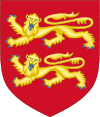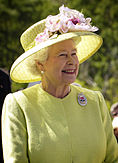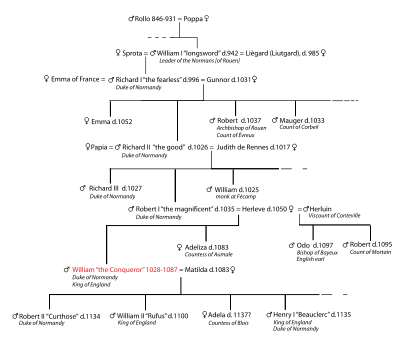- Dukes of Normandy
-
See also: Duchess of Normandy
Duke of Normandy Monarchy 
Channel Islands
Incumbent:
Elizabeth IIStyle: Her Majesty Heir apparent: Charles, Prince of Wales First monarch: Rollo Formation: 911 The Duke of Normandy is the title of the reigning monarch of the British Crown Dependancies of the Bailiwick of Guernsey and the Bailiwick of Jersey. The title traces its roots to the Duchy of Normandy (of which the Channel Islands are remnants). Whether the reigning sovereign is a male or female, they are always titled as the "Duke of Normandy". [1]
Contents
Rollo the Viking
The fiefdom of Normandy was created in 911 for the Viking leader Rollo (also known as Rolf).
After participating in many Viking incursions along the Seine, culminating in the siege of Paris in 886, Rollo was finally defeated by King Charles the Simple. With the Treaty of St.-Claire-sur-Epte, Rollo accepted to become a vassal to Charles III of France, converted to Christianity and was baptized with the name Robert. Charles then granted Rollo territories around Rouen, which came to be called Normandy after the Northmen (Latin Normanni).
Rollo and his immediate successors were styled as "counts" of Normandy. Some later medieval sources refer to them by the title dux, the Latin word from which the English word "duke" is derived; however, Rollo's great-grandson Richard II was the first to assuredly be styled "Duke of Normandy".
Although certain titles were used interchangeably during this period, the title of "duke" was typically reserved for the highest rank of feudal nobility — those who either owed homage and fealty directly to kings or who were independent sovereigns primarily distinguished from kings by not having dukes as vassals.[citation needed]
William the Conqueror
William the Conqueror added the Kingdom of England to his realm in the Norman Conquest of 1066. This created a problematic situation wherein William and his descendants were king in England but a vassal to the king in France. Much of the contention which later arose around the title Duke of Normandy (as well as other French ducal titles during the Angevin period) stems from this fundamentally irreconcilable situation.
After the death of William the Conqueror, his eldest son Robert Curthose became Duke of Normandy while a younger son, William Rufus, became the English king. In 1106, Robert was deposed by William II's successor (and Robert and William's younger brother) Henry I again uniting the titles.[citation needed]
International contention
In 1204, King Philip II of France confiscated the Duchy of Normandy held by King John of England and subsumed it into the crown lands. Only the Channel Islands remained under John's control. In 1259, Henry III of England recognised the legality of French possession of mainland Normandy under the Treaty of Paris.
English monarchs made subsequent attempts to reclaim their former continental possessions, particularly during the Hundred Years' War, and even claimed the throne of France itself.
With the Treaty of Troyes in 1420, Henry V of England temporarily regained all territories formerly held by the Plantagenets, including Normandy, and was made regent and heir of France. His son, Henry VI inherited both Kingdoms in 1422 and afterwards English monarchs included King of France among their list of titles and included the Royal Arms of France in their own armorial achievements, even after they had lost their French possessions (except for Calais) after 1450.
British claims to the throne of France and other French claims were not formally abandoned until 1801, when George III and Parliament, in the Act of Union, joined the Kingdom of Great Britain with the Kingdom of Ireland and used the opportunity to drop the obsolete claim on France. By this time, the French monarchy itself had already been overthrown with the establishment of the French Republic in 1792. The French revolution also brought an end to the Duchy of Normandy as a political entity, as it was replaced by several départements.
Channel Islands
Although the British monarchy relinquished claims to continental Normandy and other French claims in 1801, the Channel Islands (except for Chausey under French sovereignty) remain Crown dependencies of the British Crown in the present era. Unlike the Isle of Man, these islands have no specific title pertaining to them. The Loyal Toast in the Channel Islands is La Reine, notre Duc or The Queen, our Duke (or when the monarch is male, The King, our Duke), as the islands were formerly part of the Duchy of Normandy, the rest of which was renounced in 1259.[citation needed]
According to the British monarchy's official website, "In the Channel Islands The Queen is known as The Duke of Normandy. At official functions, islanders raise the loyal toast to 'The Duke of Normandy, our Queen'." It goes on to say that "In 1106, William's youngest son Henry I seized the Duchy of Normandy from his brother Robert; since that time, the English Sovereign has always held the title Duke of Normandy... While the islands today retain autonomy in government, they owe allegiance to The Queen in her role as Duke of Normandy."
List of Dukes of Normandy
- Kings of England indicated by an asterisk (*)
Early Dukes of Normandy (911-1204)
- Rollo 911-927
- William I Longsword 927-942
- Richard I 942-996
- Richard II the Good 996-1027
- Richard III 1027
- Robert I The Magnificent 1027-1035
- William II the Conqueror* 1035-1087
- Robert II Curthose 1087-1106
- William Rufus* as regent 1096-1100
- William Clito as claimant 1106-1134
- Henry I Beauclerk* 1106-1135
- William III Atheling (Under his father, Henry I)
- Stephen of Blois* 1135-1144
- House of Plantagenet
- Geoffrey Plantagenet 1144-1150
- Henry II* 1150-1189
- Henry the Young King* as junior duke 1170–1183[2]
- Richard IV Lionheart* 1189-1199
- John I Lackland* 1199-1216, lost mainland Normandy in 1204 but retained the Channel Islands
- Henry III* 1216–1259, renounced mainland Normandy by treaty
Dukes of Normandy proper (1204-1792)
In 1204, the King of France confiscated the Duchy of Normandy (with only the Channel Islands remaining under English control) and subsumed it into the crown lands of France. Thereafter, the ducal title was held by several French princes.
In 1332, King Philip VI gave the Duchy in appanage to his son John, who became king as John II in 1350. He in turn gave the Duchy in appanage to his son Charles, who became king as Charles V in 1364. In 1465, Louis XI gave the Duchy to his brother Charles de Valois, Duke of Berry; when he died in 1466, the Duchy was again subsumed into the crown lands and remained a permanent part of it.
James II was created "Duke of Normandy" by King Louis XIV of France, 31 December 1660. This was a few months after the restoration of his brother Charles II to the English and Irish thrones (Charles II had been crowned King of Scotland in 1651), and probably was done as a political gesture of support for James - since his brother also would have claimed the title "Duke of Normandy".
References
- ^ http://www.royal.gov.uk/MonarchUK/QueenandCrowndependencies/ChannelIslands.aspx
- ^ Charles Cawley (2008-10-28). "England Kings". Medieval Lands. Foundation of Medieval Genealogy. http://fmg.ac/Projects/MedLands/ENGLAND,%20Kings%201066-1603.htm#HenryKingdied1183. Retrieved 2010-01-20.
- Onslow, Richard (Earl of Onslow). The Dukes of Normandy and Their Origin. London: Hutchinson & Co., 1945.
External links
- The Dukes of Normandy: From Rollo to William of Normandy
- British Monarchy web page about the Channel Islands
Dukes of Normandy House of Normandy
911–1135Rollo · William I · Richard I · Richard II · Richard III · Robert I · William II · Robert II · Henry I · William IIIHouse of Blois
1135–1144House of Plantagenet
1144–1259British royal titles Inactive titles Categories:- Dukes of Normandy
- Dukedoms of France
- Lists of French nobility
- Normandy
- Lists of dukes
Wikimedia Foundation. 2010.




